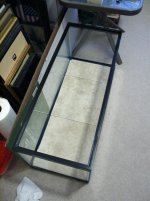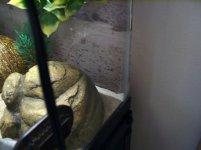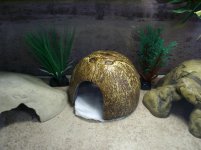Freshover9000
New member
I have a few questions and topics I need help with. (i had a whole thing typed out and boswer refreshed -_-) So ill get to the point.
So I measured this morning, for my 20gal tank, I'll need 29 1/2 by 12, 1/4 thick.
-Is slate the preferred tile?
I'm changing to tile from carpet do to heat control and cleaner.
I have a UTH and CHE to heat up the tank.
Do i place the UTH(new one of course) under the tile or do I keep it under the tank?
-How long will it take to warm up to preferred temp? I have a Jumpstart on the UTH and dimmer on the CHE.
-Where do i place the termo probif i get tile?
Also have 40watt day and night bulbs for light, they really dont add to ground heat, slight air temp.
-I've been hearing about puting sand or sealant in the cracks/edges of the tile, is this necessary? I'm just not grasping the idea, due to I don't have the tile today(hopefully getting today). Can i just use the carpet to fill the spaces?
-I'm also having Moist/Humid hide issues. I currently have Zilla Decor Rock Lair Size Medium [http://a.co/1CfvVII] I think the buttom is too thick. The temps are good, but they fluctuate a lot. But I cant keep it moist, especially the entrance.
-Is the hide supposed to be humid that condensation is in the inside? if so that has not happen. I'm using sphagnum moss. half on heat mat half on cool side.
She sheds fine, the first time I had her and she shedded, i got to see the process. the next three time she did it all on her own, quick and easy. Ill see that she whiteish in the morning then later the night she back to normal.
But i plan on buying Exo Terra Gecko Cave for Reptiles [http://a.co/aCIlQiW] to see if it helps.
Thank you.
So I measured this morning, for my 20gal tank, I'll need 29 1/2 by 12, 1/4 thick.
-Is slate the preferred tile?
I'm changing to tile from carpet do to heat control and cleaner.
I have a UTH and CHE to heat up the tank.
Do i place the UTH(new one of course) under the tile or do I keep it under the tank?
-How long will it take to warm up to preferred temp? I have a Jumpstart on the UTH and dimmer on the CHE.
-Where do i place the termo probif i get tile?
Also have 40watt day and night bulbs for light, they really dont add to ground heat, slight air temp.
-I've been hearing about puting sand or sealant in the cracks/edges of the tile, is this necessary? I'm just not grasping the idea, due to I don't have the tile today(hopefully getting today). Can i just use the carpet to fill the spaces?
-I'm also having Moist/Humid hide issues. I currently have Zilla Decor Rock Lair Size Medium [http://a.co/1CfvVII] I think the buttom is too thick. The temps are good, but they fluctuate a lot. But I cant keep it moist, especially the entrance.
-Is the hide supposed to be humid that condensation is in the inside? if so that has not happen. I'm using sphagnum moss. half on heat mat half on cool side.
She sheds fine, the first time I had her and she shedded, i got to see the process. the next three time she did it all on her own, quick and easy. Ill see that she whiteish in the morning then later the night she back to normal.
But i plan on buying Exo Terra Gecko Cave for Reptiles [http://a.co/aCIlQiW] to see if it helps.
Thank you.




